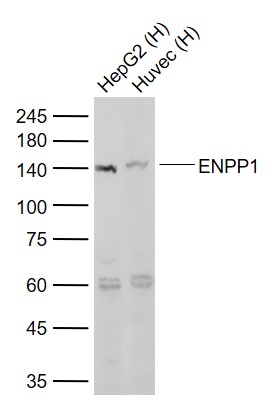
Rabbit Anti-ENPP1 antibody
Alkaline phosphodiesterase 1; ARHR2; E-NPP 1; Ectonucleotide pyrophosphatase/phosphodiesterase 1; Ectonucleotide pyrophosphatase/phosphodiesterase family member 1; ENPP1_HUMAN; Ly 41 antigen; M6S1; Membrane component chromosome 6 surface marker 1; NPP1; N
View History [Clear]
Details
Product Name ENPP1 Chinese Name 核苷酸内焦磷酸酶/磷酸二酯酶1抗体 Alias Alkaline phosphodiesterase 1; ARHR2; E-NPP 1; Ectonucleotide pyrophosphatase/phosphodiesterase 1; Ectonucleotide pyrophosphatase/phosphodiesterase family member 1; ENPP1_HUMAN; Ly 41 antigen; M6S1; Membrane component chromosome 6 surface marker 1; NPP1; NPPase; NPPS; Nucleotide pyrophosphatase; PC-1; PCA1; PDNP1; Phosphodiesterase I/nucleotide pyrophosphatase 1; Plasma cell membrane glycoprotein 1; Plasma-cell membrane glycoprotein PC-1. literatures Research Area Tumour immunology Signal transduction Kinases and Phosphatases Immunogen Species Rabbit Clonality Polyclonal React Species Human, (predicted: Mouse, Rat, Rabbit, ) Applications WB=1:500-2000 ELISA=1:5000-10000
not yet tested in other applications.
optimal dilutions/concentrations should be determined by the end user.Theoretical molecular weight 100kDa Cellular localization cytoplasmic Form Liquid Concentration 1mg/ml immunogen KLH conjugated synthetic peptide derived from human ENPP1: 251-350/925 <Extracellular> Lsotype IgG Purification affinity purified by Protein A Buffer Solution 0.01M TBS(pH7.4) with 1% BSA, 0.03% Proclin300 and 50% Glycerol. Storage Shipped at 4℃. Store at -20 °C for one year. Avoid repeated freeze/thaw cycles. Attention This product as supplied is intended for research use only, not for use in human, therapeutic or diagnostic applications. PubMed PubMed Product Detail ENPP1 has a broad specificity and cleaves a variety of substrates, including phosphodiester bonds of nucleotides and nucleotide sugars and pyrophosphate bonds of nucleotides and nucleotide sugars. It can hydrolyze nucleoside 5' triphosphates such as ATP, GTP, CTP, TTP and UTP to their corresponding monophosphates with release of pyrophosphate. It can also hydrolyze diadenosine polyphosphates and 3',5'-cAMP to AMP. It may play a role in the regulation of pyrophosphate production, the regulation of the availability of nucleotide sugars in the endoplasmic reticulum and Golgi, and the regulation of purinergic signaling.
The subtilisin-like Prohormone Convertase (PC) family is a group of cellular enzymes that cleave most prohormones and neuropeptide precursors. Numerous other cellular proteins, some viral proteins, and bacterial toxins that are transported by the constitutive secretory pathway are also targeted for maturation by PCs. PC family members share structural similarities, which include a heterogeneous ~10 kDa amino-terminal proregion, a highly conserved ~55 kDa subtilisin-like catalytic domain, and carboxyl-terminal domain that is heterogeneous in length and sequence. These enzymes become catalytically active following proregion cleavage within the appropriate cellular compartment. The subcellular localization of PC family members varies. Immunolocalization studies show that PC1 is found in the perinuclear region as well as the trans-Golgi network, whereas PC2 can be found in the trans-Golgi network as well as diffusely distributed in the peripheral cytoplasm.
Function:
Involved in the processing of hormone and other protein precursors at sites comprised of pairs of basic amino acid residues. Substrates include POMC, renin, enkephalin, dynorphin, somatostatin and insulin.
Subunit:
Homodimer; disulfide-linked.
Subcellular Location:
Cytoplasmic
Tissue Specificity:
Expressed in plasma cells and also in a number of non-lymphoid tissues, including the distal convoluted tubule of the kidney, chondrocytes and epididymis.
DISEASE:
Defects in PCSK1 are the cause of proprotein convertase 1 deficiency (PC1 deficiency) [MIM:600955]. PC1 deficiency is characterized by obesity, hypogonadism, hypoadrenalism, reactive hypoglycemia as well as marked small-intestinal absorptive dysfunction It is due to impaired processing of prohormones.
Similarity:
Belongs to the peptidase S8 family. Furin subfamily.
SWISS:
P22413
Gene ID:
5167
Database links:Entrez Gene: 5167 Human
Entrez Gene: 18605 Mouse
Omim: 173335 Human
SwissProt: P22413 Human
SwissProt: P06802 Mouse
Unigene: 527295 Human
Unigene: 27254 Mouse
Unigene: 1199 Rat
Product Picture
Bought notes(bought amounts latest0)
No one bought this product
User Comment(Total0User Comment Num)
- No comment



 +86 571 56623320
+86 571 56623320
 +86 18668110335
+86 18668110335

